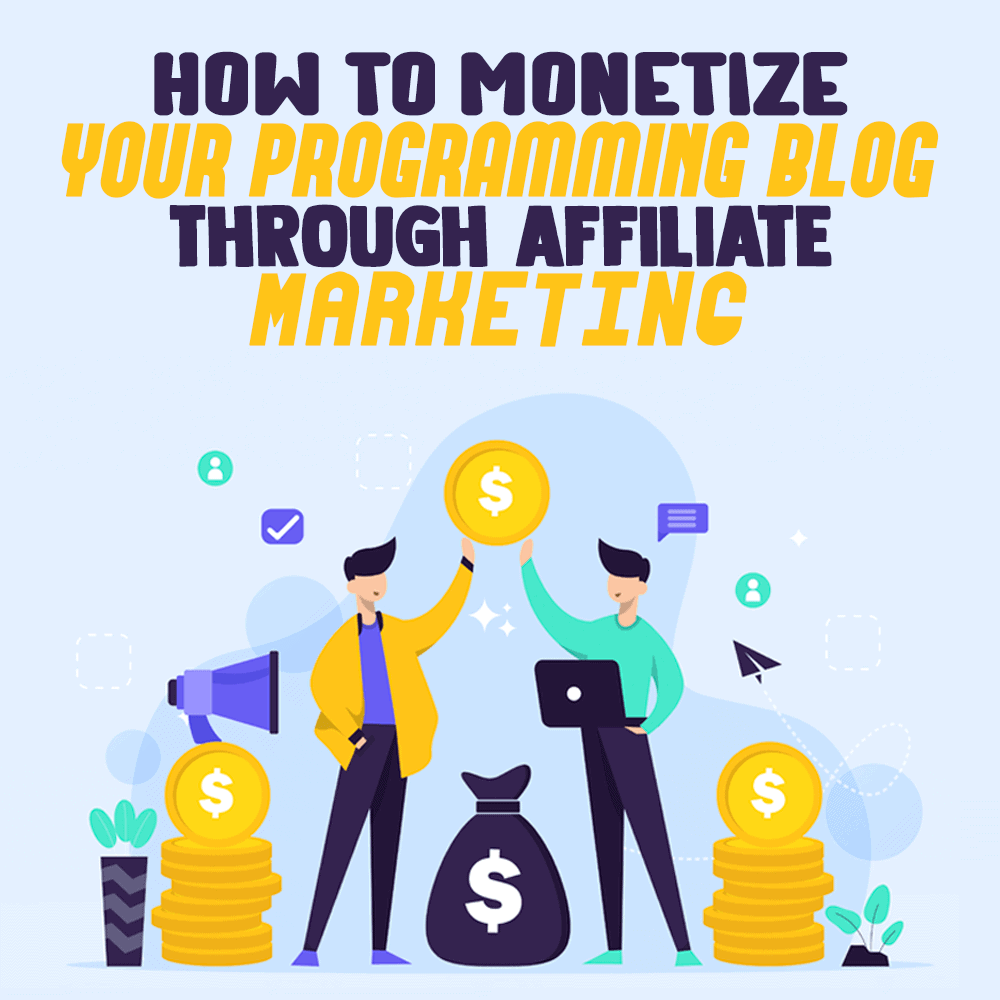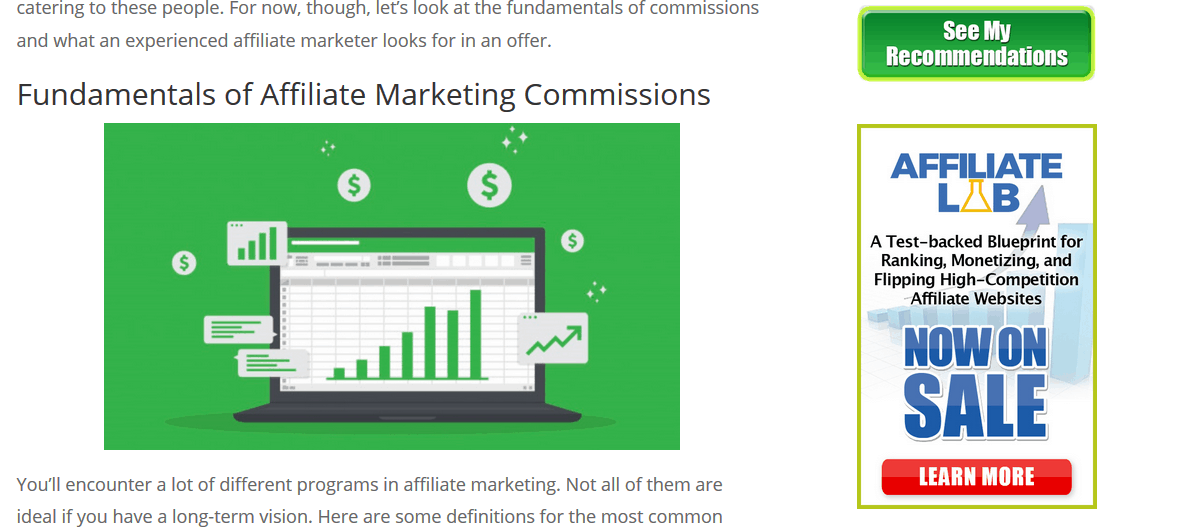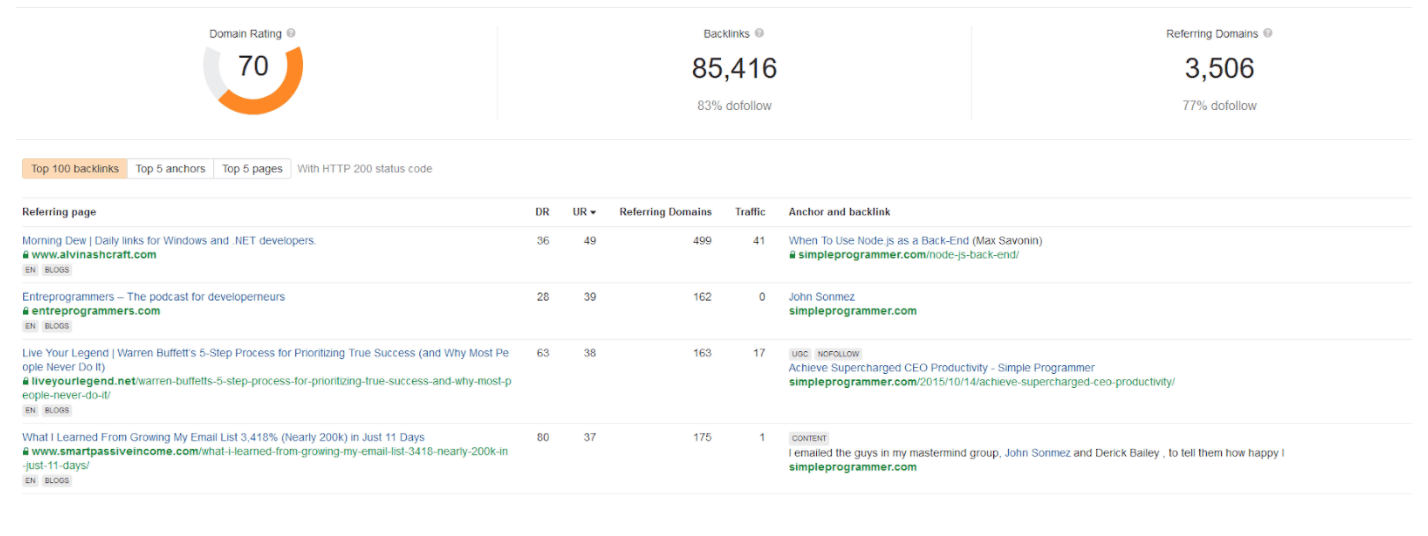
But did you know you can also make money blogging?
Or perhaps you already run a programming blog, but you have not yet monetized it. If so, you’re missing out on a potentially lucrative income stream. Affiliate marketing is one of the most effective ways to monetize blog content. Even if you aren’t interested in blogging, you might find this information useful if you’re a programmer setting up a website for a client.
In this article, you’ll learn about affiliate marketing and how to get started using it to monetize a programming blog, whether your own or a client’s.
What Is Affiliate Marketing?
Affiliate marketing is a type of revenue sharing. You, the affiliate, promote products or services for another business, the merchant, using a unique code or referral link. When someone makes a purchase using your link, you earn a commission at an agreed percentage. Affiliate commissions can range from 2%-50%, depending on the offer.
The reason I teach affiliate marketing is this: because it works. I’m not one to make grandiose income claims or promise that you’ll be able to quit your day job in six months. However, I can tell you that a 2017 study indicated that 9% of affiliate marketers make more than $50,000 per year, while 65% earn between 5% and 20% of their annual income from affiliate marketing.
There are also virtually no start-up costs, especially if you already have a blog or website with traffic. You should never have to pay to join an affiliate program, and you do not have to buy any products or services.
The other advantage of affiliate marketing is that it allows you to earn passive income. For as long as your links remain live, you will make money whenever somebody clicks on one and makes a purchase.
It’s important to manage your expectations, however. Affiliate marketing is not a get-rich-quick scheme. It takes time and effort to grow your affiliate income. If you already have a blog with a large readership, you will probably see results more quickly. But if you’re starting from scratch, it could be months before you see a substantial return.
The nature of affiliate marketing also means there are no income guarantees. You don’t get paid until someone uses your link to buy a product from the merchant. Your income is likely to fluctuate month to month, and sometimes for reasons entirely outside of your control.
Some affiliate marketers have seen a drop in their income in recent months due to the COVID-19 crisis and its impact on sales—thanks to job losses and looming threats of recession, many consumers are watching their spending.
Other affiliate marketers have seen a drop as a result of the change in commissions for the Amazon Associates program (Amazon drastically cut its commissions across many programs, and ceased to run some altogether, in April of 2020).
Fortunately, the big-picture impact of COVID-19 on tech and software industry conversions has been relatively minimal.
If there’s one message I want you to take away, it’s this: The more you put into your affiliate marketing strategy, the more you’ll get out. Let’s see how.
How To Choose the Right Affiliate Programs to Join and Products to Promote
Since you run a programming blog, you’ll want to focus on promoting products and services relevant to that niche.
This might include physical products such as computers and associated hardware, informational products such as programming courses and books, and services such as web hosting and VPNs. Commission rates tend to be higher for informational products and services than for physical products. Hosting and VPN services are among the most profitable niches for affiliate marketers.
When promoting an offer, don’t be afraid to think outside the box. You might write about healthy office habits for programmers who tend to sit at their desks all day, and use this opportunity to promote ergonomic desk chairs or at-home workout gear.
How Do I Find Networks to Join?

There are two main ways to join an affiliate program: directly through the merchant, or via an affiliate network such as ClickBank, Rakuten, or ShareASale.
Newer affiliate marketers will usually start by going through affiliate networks. ShareASale and Impact are great affiliate networks for tech bloggers, offering both physical computing products and IT services. Rakuten is fantastic if you want to promote informational products such as online courses.
If a merchant runs its own affiliate program, you’ll usually find the details through a tab labelled “Affiliates” on the website. You will need to apply, either through a form or by email. For the larger affiliate networks, you will apply online through the network’s own site.
Explore Your Keywords and Search Terms
What search terms are readers using to find your blog? Do a deep dive into your Google Search Console analytics and see which keywords bring the most traffic to your blog. Focusing your affiliate content around those terms will give you crucial insight into which affiliate marketing offers are most likely to convert.
If, for example, you discover that a lot of people are finding your blog through the search term “learn to code in Python,” you might promote informational products for people who want to learn this programming language.
How To Create a Content Strategy
The quality of your content is the single most important factor in your affiliate marketing success.
If you provide consistently high-quality, readable content that offers value to your readers, you will build a base of loyal fans who trust you. This trust is a precious and valuable commodity. Your readers will only buy products based on your recommendations if they believe what you have to say.
Your content strategy is part of your overall marketing for your personal brand and your business. Each decision you make—the type of content you put out, how often you publish, the tone and voice you use, and the affiliate products you promote—must feed into your wider marketing goals.
I recommend using an editorial calendar. You don’t have to stick to it with absolute rigidity, but it will help you stay organized and approach your content in a strategic fashion.
In this section, we’ll talk about the best types of affiliate marketing content for programming bloggers.
How-To Guides
It’s likely that many of your readers return to your blog time and again because you provide a valuable resource. Whether you share tutorials on your favorite programming language, advice for those looking to launch a career in the industry, or hacks for debugging code, accessible and actionable advice will build a loyal readership.
You can include affiliate links naturally within your how-to content. You might suggest a tool that can help your readers solve their coding problems or recommend a book or course where they can find more information on a particular subject.
The conversion rate from these offers will be low, as this content has a low user intent. User intent simply means what the customers’ intention was in coming to your page or site. If they weren’t looking for a specific product or solution, the user intent is likely to be low.
Industry News and Views

Take the time to read industry news, form your own opinions about it, and share those opinions with your readers. You can include your affiliate links at natural points within the content. Again, don’t expect high conversions from this type of content.
Product Reviews
Product reviews are one of the most popular types of affiliate marketing content, and for a good reason. They are highly effective. Research shows 91% of consumers read online reviews, and 84% consider them as reliable as a personal recommendation.
Reviews work particularly well for affiliate marketers in the tech niche because computing goods and services are often high-ticket products. Therefore, consumers are very likely to read reviews before purchasing to ensure they get good value.
Your reviews should be as detailed and in-depth as possible, covering all the product’s relevant features, as well as pros and cons. Include high-quality pictures and, if possible, video content.
It’s vital to be honest. Don’t recommend a product if you found it lacking. A quick commission isn’t worth eroding your readers’ trust. Instead, explain why you cannot recommend this particular product and suggest an alternative that is more fit for purpose.
You can review a wide range of tech products and services, or specialize in one particular niche category. You must decide which makes the most sense for your blog and readers.
Round-ups or Comparisons
Round-ups or comparison pieces list several products and discuss the features, benefits, and drawbacks of each. They are ideal for helping people decide between two or more products.
Here are some examples you might consider:
- The Best Coding Courses for Beginners
- 10 Best Keyboards for Programmers
- ExpressVPN or Surfshark: Which VPN Is Best for Tech Professionals?
Follow the same rule for round-ups as we just discussed for reviews: Be honest. If you tell your readers that something is amazing when it isn’t, you’ll lose their trust forever.
Monetize Your Most Popular Content
If you’re serious about growing your blog, you should be reviewing your stats regularly. Using Google Analytics, you can see which pieces of content are the most popular. The results might surprise you. I know of bloggers whose most-read piece of content is something they published years ago.
It makes sense to go back and edit old content that is still getting a lot of views to insert your affiliate links. You don’t have to do this with every single old post, but monetizing the top five or ten pieces can make all the difference.
Mix up Your Content, but Be Strategic
You don’t have to choose just one type of content and stick to it, but you should have a consistent content strategy. A regular content schedule is ideal if you can manage it. Perhaps, for example, you could post a product review on Mondays, a coding tutorial on Wednesdays, and an industry news round-up on Saturdays.
Use Banner Ads
While the regularly updated content on your blog is vitally important, you shouldn’t forget about the more static elements of your blog and website.
The sidebar on your blog is valuable space. Are you using it to its full potential? If your affiliate network provides visual assets such as banner ads (and most do), insert some of these into your blog sidebar. Here’s how I do it on Diggity Marketing:
Sidebar ads get fewer click-throughs than links inserted organically into content, but they are still worth using. I recommend changing them now and then to encourage new clicks.
Grow Your Email List
You’ve probably heard the saying thousands of times: “The money is in the list.” There’s an element of truth behind this saying.
Email is a marketing channel with one of the highest returns on investment. This is because you can develop a relationship with your readers. You can then leverage that relationship, and the trust that you have built, to sell them a product or service of your own or recommend the products or services of another.
The underlying principles behind growing an email list are pretty simple. I recommend using a lightbox or an opt-in form, either in a post or on your sidebar, to collect email leads. You can then send these new subscribers engaging content around your industry, and special offers.
How To Generate More Traffic to Your Site
The best way to reach your affiliate marketing goals is to make sure the right people can find your site. Therefore, focusing on your SEO to improve your ranking on search engine results pages (SERPs) is essential.
Your backlink profile refers to how many other websites link to yours. The more backlinks you have, and the higher the authority of the sites that they come from, the better your SERP ranking will be.
For bloggers, guest posting is a fantastic strategy for acquiring high-quality backlinks. Guest posting means providing a piece of content to another blog or website in exchange for a link back to yours.
Finding Guest Posting Opportunities
Use Ahrefs’ backlink checker and search for a high performing site in your niche:
Studying that website’s backlink profile will reveal sites you could approach for guest blogging opportunities. Discount any that aren’t related to coding, programming, or the tech industry. I also recommend removing any site with a Domain Rating (DR) of below 50.
Once you’ve got a list of sites to target, send a polite email to the editors introducing yourself and asking if they would be interested in a guest post. If you have a particular area of expertise—for example, if you know an unusual programming language—highlight it in your outreach email.
Establish Your Site as a Resource
If you provide informational or advice-based content, you can build up an organic profile of backlinks by becoming known as a valuable resource in your niche. For example, if colleagues and fellow bloggers in the industry know that your C++ tutorials are second to none, they are likely to recommend you to their readers.
Becoming a well-known and trusted authority takes time, and is not a strategy you can rely on for quick wins. But those organic backlinks, where people have recommended your content for no other reason than because they genuinely believe it is valuable, are the best kind you can get.
Utilize Your Social Media Channels (Including Paid Ads)
Social media is one of the biggest sources of referral traffic online. Which channels you use will depend on where your audience is. If you write a serious blog for industry experts, LinkedIn and Twitter should probably be a focus. On the other hand, if you write informal content aimed at young people who are just starting in the industry, Facebook or even Instagram might be a better bet.
Share links to your blog posts on social media with a one-line summary or snapshot to entice readers to click on it. You should also create content specifically for your social media channels. Using images, infographics, video, and audio content will increase engagement with your posts and click-throughs to your blog.
You can share your affiliate links directly on your social media channels where the platform permits it, but remember that the main goal is to drive traffic back to your blog.
You also shouldn’t shun paid social media ads. Paid social media placements, such as Facebook ads and promoted tweets, can be vital for affiliate marketers. When you create your ad, remember that the goal is to encourage people to click through to your blog or a sales page.
You might be able to avoid paid advertising at first, but if you want to take your blog and your affiliate marketing to the next level, you’ll need to invest in it. Be willing to spend money to make money, as the saying goes!
Be Consistent and Be Patient
Affiliate marketing is not a game of overnight success. Persistence, consistency, and patience are the keys to making this income stream work for you.
However, I’ve seen time and time again how effective affiliate marketing can be. In the current climate, where most people are staying at home and e-commerce is experiencing a boom, it’s the ideal time to get started.
If you run a programming blog, you’re well placed to tap into the highly lucrative tech products and services niche. And who knows? If you don’t blog already, maybe this article has inspired you to give it a go!
Here’s to making your first sale!


